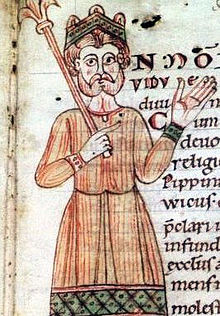Lothair II, Holy Roman Emperor
| Lothair II | |
|---|---|

Portrait of Lothair in the Codex Eberhardi, Fulda monastery 1150/60
|
|
| Holy Roman Emperor | |
| Reign | 1133–1137 |
| Coronation | 4 June 1133, Rome |
| Predecessor | Henry V |
| Successor | Frederick I |
|
King of Germany (formally King of the Romans) |
|
| Reign | 1125–1137 |
| Coronation | 13 September 1125, Aachen |
| Predecessor | Henry V |
| Successor | Conrad III |
| King of Italy | |
| Reign | 1125–1137 |
| Predecessor | Henry V |
| Successor | Conrad III |
| Born | before 9 June 1075 Lutterloh, Duchy of Saxony |
| Died |
4 December 1137 (aged 62) Breitenwang, Tyrol, Duchy of Bavaria |
| Burial | Königslutter |
| Spouse | Richenza of Northeim |
| Issue | Gertrude of Süpplingenburg |
| House | Supplinburg |
| Father | Gebhard of Supplinburg |
| Mother | Hedwig of Formbach |
| Religion | Roman Catholicism |
| German royal dynasties | |||
| Süpplingenburg dynasty | |||
| Chronology | |||
| Lothair III | 1125 – 1137 | ||
| Family | |||
|
Family tree of the German monarchs |
|||
| Succession | |||
|
Preceded by Salian dynasty |
Followed by House of Hohenstaufen |
||
Lothair II or Lothair III (before 9 June 1075 – 4 December 1137), known as Lothair of Supplinburg, was Holy Roman Emperor from 1133 until his death. He was appointed Duke of Saxony in 1106 and elected King of Germany in 1125 before being crowned emperor in Rome. The son of the Saxon count Gebhard of Supplinburg, his reign was troubled by the constant intriguing of the Hohenstaufens, Duke Frederick II of Swabia and Duke Conrad of Franconia. He died while returning from a successful campaign against the Norman Kingdom of Sicily.
Little is known of Lothair's youth. His father joined the Saxon Rebellion against the ruling Salian dynasty and died on 9 June 1075 in the Battle of Langensalza, fighting troops loyal to Emperor Henry IV. Shortly thereafter, Lothair was born posthumously at Unterlüß. In 1100 he married Richenza, daughter of Count Henry of Northeim and Gertrude of Brunswick, heiress of the Brunonids.
After years of purchasing lands or gaining them via inheritance or marriage alliances throughout Saxony, Lothair gained the domains of the House of Billung, the Counts of Northeim and the Brunonids, and became one of the dominant landowners in the North German duchy. He backed the emperor's son Henry V during the disempowerment of his father Henry IV and in turn was made Duke of Saxony upon the death of Magnus of Billung in 1106. Emboldened by the promotion and incensed over the imposition of a new tax on ducal lords, however, Duke Lothair subsequently revolted against Emperor Henry's rule and denied his ability to rule Saxony during the Investiture Controversy. He acted autonomously, vesting Count Adolf of Schauenburg with Holstein in 1110, was temporarily deposed in 1112 but reinstated after he tactically submitted himself to the rule of Henry V. In 1115 however, he joined the rebellious Saxon forces which defeated those of the Emperor in the Battle of Welfesholz. When in 1123 Henry V vested Count Wiprecht of Groitzsch with the Margraviate of Meissen, Lothair enforced the appointment of Conrad of Wettin and ceded the March of Lusatia to Count Albert the Bear.
...
Wikipedia
